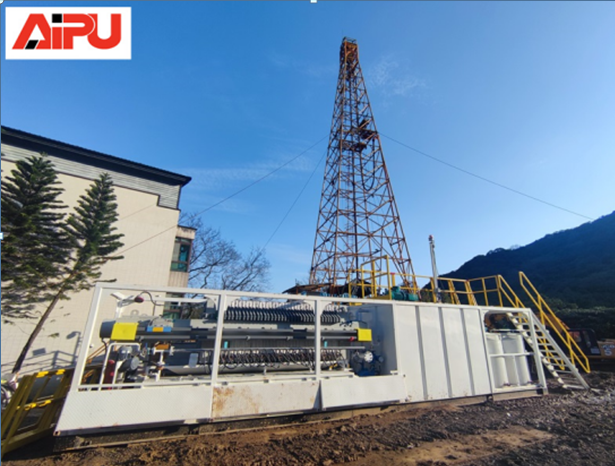Enhancing Tunnel Drilling Efficiency with Advanced Equipment
High - pressure drilling presents a multitude of challenges, and solids control equipment plays a crucial role in meeting these difficulties head - on. This article delves into the various aspects of how solids control equipment addresses the unique requirements of high - pressure drilling.
Understanding High - Pressure Drilling Challenges
High - pressure drilling involves working in extreme conditions where the pressure exerted on the wellbore can be extremely high. One of the primary challenges is the presence of large amounts of solids in the drilling fluid. These solids, if not properly controlled, can cause significant wear and tear on the drilling equipment, reduce the efficiency of the drilling process, and even lead to wellbore instability. Additionally, high - pressure environments can cause the drilling fluid to behave differently, making it more difficult to separate the solids from the fluid.
Key Features of Solids Control Equipment
Solids control equipment is designed with several key features to tackle the challenges of high - pressure drilling. First, it has robust construction to withstand the high pressures. The equipment is made from high - strength materials that can resist deformation and damage under extreme pressure. Second, it is equipped with advanced separation technology. For example, shale shakers use high - frequency vibrations to effectively separate large solids from the drilling fluid. Hydrocyclones, on the other hand, rely on centrifugal force to separate finer solids. These technologies ensure that the drilling fluid is cleaned to an acceptable level, reducing the risk of equipment damage and improving drilling efficiency.
Benefits of Using Solids Control Equipment in High - Pressure Drilling
The use of solids control equipment in high - pressure drilling offers numerous benefits. Firstly, it extends the lifespan of the drilling equipment. By removing solids from the drilling fluid, the wear and tear on pumps, drill bits, and other components are significantly reduced. This not only saves on replacement costs but also minimizes downtime for equipment maintenance. Secondly, it improves the quality of the drilling fluid. A cleaner drilling fluid provides better lubrication and cooling, which is essential for smooth and efficient drilling operations. Finally, it enhances wellbore stability. By maintaining the proper properties of the drilling fluid, solids control equipment helps prevent wellbore collapse and other stability issues.
Future Developments in Solids Control Equipment for High - Pressure Drilling
The future of solids control equipment for high - pressure drilling looks promising. There is ongoing research and development to improve the efficiency and performance of the equipment. For instance, new materials are being explored to make the equipment even more resistant to high pressures and corrosive environments. Additionally, advancements in automation and control systems are expected to make the solids control process more precise and less labor - intensive. These developments will further enhance the ability of solids control equipment to meet the ever - increasing challenges of high - pressure drilling.

Understanding High - Pressure Drilling Challenges
High - pressure drilling involves working in extreme conditions where the pressure exerted on the wellbore can be extremely high. One of the primary challenges is the presence of large amounts of solids in the drilling fluid. These solids, if not properly controlled, can cause significant wear and tear on the drilling equipment, reduce the efficiency of the drilling process, and even lead to wellbore instability. Additionally, high - pressure environments can cause the drilling fluid to behave differently, making it more difficult to separate the solids from the fluid.
Key Features of Solids Control Equipment
Solids control equipment is designed with several key features to tackle the challenges of high - pressure drilling. First, it has robust construction to withstand the high pressures. The equipment is made from high - strength materials that can resist deformation and damage under extreme pressure. Second, it is equipped with advanced separation technology. For example, shale shakers use high - frequency vibrations to effectively separate large solids from the drilling fluid. Hydrocyclones, on the other hand, rely on centrifugal force to separate finer solids. These technologies ensure that the drilling fluid is cleaned to an acceptable level, reducing the risk of equipment damage and improving drilling efficiency.
Benefits of Using Solids Control Equipment in High - Pressure Drilling
The use of solids control equipment in high - pressure drilling offers numerous benefits. Firstly, it extends the lifespan of the drilling equipment. By removing solids from the drilling fluid, the wear and tear on pumps, drill bits, and other components are significantly reduced. This not only saves on replacement costs but also minimizes downtime for equipment maintenance. Secondly, it improves the quality of the drilling fluid. A cleaner drilling fluid provides better lubrication and cooling, which is essential for smooth and efficient drilling operations. Finally, it enhances wellbore stability. By maintaining the proper properties of the drilling fluid, solids control equipment helps prevent wellbore collapse and other stability issues.
Future Developments in Solids Control Equipment for High - Pressure Drilling
The future of solids control equipment for high - pressure drilling looks promising. There is ongoing research and development to improve the efficiency and performance of the equipment. For instance, new materials are being explored to make the equipment even more resistant to high pressures and corrosive environments. Additionally, advancements in automation and control systems are expected to make the solids control process more precise and less labor - intensive. These developments will further enhance the ability of solids control equipment to meet the ever - increasing challenges of high - pressure drilling.








